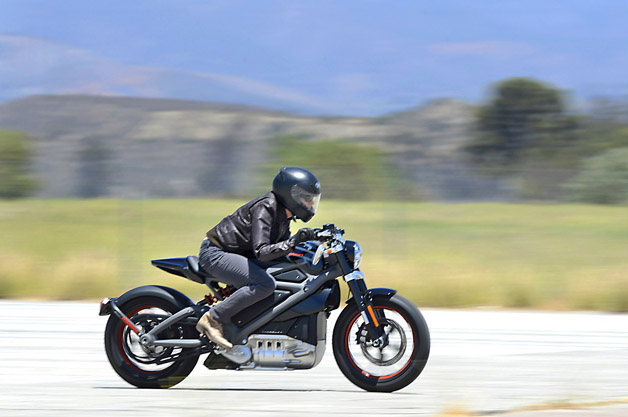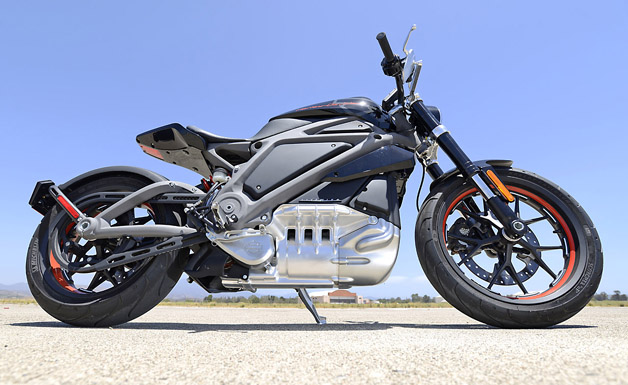- Engine:
- AC Induction Motor
- Power:
- 74 HP / 52 LB-FT
- Transmission:
- Single-Speed
- 0-60 Time:
- 4.0 Seconds (est.)
- Top Speed:
- 92 MPH
- Drivetrain:
- Rear-Wheel Drive
- Curb Weight:
- 360 LBS (est.)
- Seating:
- 1
- MPG:
- 60-Mile Range (est.)
The country's largest and most iconic motorcycle maker had set up shop on a remote strip of SoCal asphalt, a pair of top-secret LiveWires at the ready. The trailer that had carried them was unmarked, and with the exception of two Harley employees, no one was around to notice that the motorcycle silently blazing down the runway was from Milwaukee's finest. If it weren't for the black-and-orange color scheme or bar-and-shield badge, the LiveWIre's provenance would be a wild guess. It's just that different from the cruisers Harley has cranked out for decades.
Gone is the laid-back riding position, along with the bigger-is-better profile and long-haul-touring floorboards. In their place: a compact machine with an aggressive, forward-leaning stance and sporty centered foot pegs. Even the trellis frame is more Ducati than hog, hiding, as it does, a stack of lithium ion batteries instead of proudly showcasing a hulking, 103-cubic-inch V-twin. There is no gas tank. No exhaust. Just a bobbed tail suspended on a monoshock above a rear tire driven with a belt instead of a chain.
The LiveWire ignition is keyless and, like most Harleys, works in combination with a fob, but that's where the similarities end. Turning it on is a matter of flipping a switch on the right grip – an act that isn't greeted with the nearly trademarked, and now electronically programmed, potato-potato-potato exhaust note. Instead, there is a low-grade hum as an oil pump kicks in to cool the 74-horsepower electric motor bolted to its belly and a second pump that cools its ECU.

Before I could take off, I was prompted to make a decision: Power or Range? On a full charge, Power allows about 30 miles of riding with an unbridled 52 pound-feet of torque. Range mode Novocaines the throttle response but nearly doubles the distance.
I made the only logical choice. I touched my gloved finger to the screen to select Power. The throttle was live.Before I could take off, I was prompted to make a decision: Power or Range?
While its useable range is an issue, Harley got a lot of things right with its LiveWire, including its name. Twisting the grip nearly jolted me from the saddle with acceleration similar to that of a Ferrari. While the torque rating of the LiveWire is about half of a gas-powered 2014 Harley tourer, it is instantly available. Harley claims a 0-60 time of four seconds flat. I wasn't wired to corroborate the claim, but my speedometer was calculating as quickly as Stephen Hawking as I got the LiveWire to its governed top speed of 92 miles per hour, with plenty of runway to spare.
The only sound from the bike was a slight whir that increased in pitch with speed. Harley custom designed the note to replicate a jet engine, but, to my ears, it sounds like the other two electric motorcycles that are currently duking it out in the market: Zero Motorcycles and Brammo. The "Loud Pipes Save Lives" Harley brigade is likely to have a tough time with LiveWire in this regard.
Compared to the existing electric motorcycles on the market, the LiveWire is similar in its responsiveness off the line to the 2014 models from Zero and Brammo, but it offers only half the range. Its motor and battery placement, dual ride modes and regenerative braking setup were clearly benchmarked, though the way Harley has chosen to disguise its powertrain is unique and probably the most attractive of the bunch. Even though this isn't a production bike, the LiveWire's fit and finish also far surpasses its rivals.
